Thanksgiving is a time when families gather together to enjoy good food and to remember all the things we have to be grateful for. Unfortunately, one part of our family often gets left out – our dogs! It must be frustrating for them to smell all the wonderful aromas coming from the kitchen, but not be able to share in the feast. We’re here to relieve that vexing situation with recipes for some healthy Thanksgiving dishes just for them.
Below are recipes you can use to give your dogs a special treat on this wonderful holiday, or to use up leftovers afterwards. Note these recipes are fine to feed occasionally, but they are not a complete diet.
One serving of each of the three recipes together, or three servings of either of the first two recipes alone, would provide a complete meal for a dog weighing about 25 pounds. One serving of any of the three recipes individually could be used to supplement the same dog’s regular diet (reduce the amount you usually feed by one-third to account for the extra calories). All recipes are low in fat, and leftovers can be frozen for later use.
Why Shouldn’t Our Dogs Just Share Our Dinner?
We are warned over and over again that sharing human food with dogs can be dangerous. That’s true if you’re sharing fatty foods or scraps, such as turkey skin or pan drippings, cheese, bacon, or butter. Too much fat can lead to pancreatitis, particularly in dogs accustomed to eating a low-fat commercial diet. Sugary treats such as pumpkin pie are also not a good idea, since they may cause tummy upset, as well as providing unneeded calories that contribute to obesity. Cooked bones can perforate the esophagus, stomach, or intestines and cause impactions, and should never be fed to dogs.In addition to these foods, certain ingredients can also cause problems for dogs, including:
–Xylitol, used as a sugar substitute in some baked goods, sugar-free gum, candy, and toothpaste, can cause life-threatening hypoglycemia in dogs, even in small amounts – as little as five sticks of sugar-free gum can sicken a 44-pound dog.
–Macadamia nuts can cause paralysis; fortunately this resolves within about 24 hours.
–Grapes and raisins can cause kidney failure in dogs.
–Onions cause a form of anemia and should not be fed (very small amounts in leftovers would be okay).
–Garlic is similar but much less potent, so small amounts can be used for flavoring.
–Nutmeg and sage are safe in very small amounts, but too much can cause gastrointestinal upset and central nervous system depression or excitement.
–Chocolate, coffee, and caffeine are all dangerous for dogs (dark chocolate is more toxic than milk chocolate).Yeast dough can expand in the dog’s stomach causing pain and even rupture.
–Milk can cause stomach upset due to lactose intolerance (yogurt and cottage cheese are low in lactose and are good to feed).
Foods Okay To Share with Dogs
There are many foods that can be safely shared with dogs. As long as your dog doesn’t have a health problem that requires a special diet, there’s no reason you can’t feed a special meal on this holiday. Just be careful what you offer. Make good choices and limit amounts to help your dog enjoy the holiday without suffering from overindulgence afterward.Some foods, such as turkey meat (without the skin) can be shared without needing any special preparation, but other dishes may require changes to make them appropriate for dogs. Set aside a portion during preparation, before adding butter, cheese, sugar, onions, or other high-fat and high-calorie ingredients, to make servings appropriate for dogs.
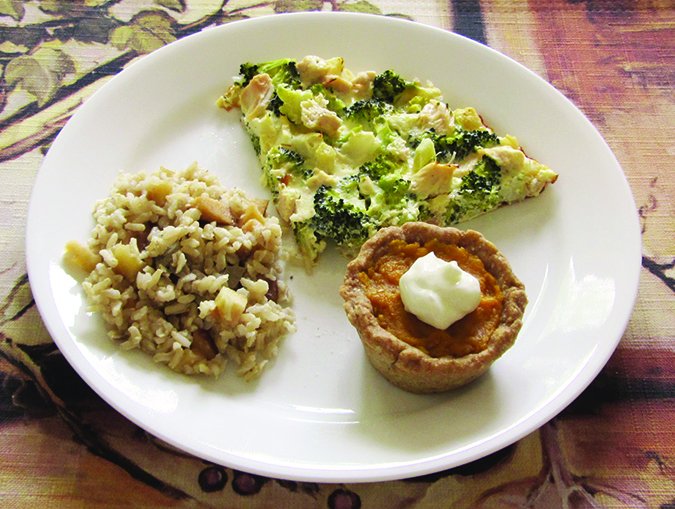
Try putting food into a Kong or other hollow toy. Your dog will enjoy the challenge of removing his treat, and the task will keep your dog occupied while the rest of the family enjoys their dinner. Add plain yogurt and freeze ahead of time to make the treat last even longer.
Holiday Recipes for Dogs
Anyone who knows me well knows that I don’t cook, so when I was asked to create some Thanksgiving recipes for dogs, I panicked. Recipes? I’m the one who has argued against the use of recipes for homemade diets (I prefer diet guidelines so that the same food is not fed every day), and against the need to create special recipes for dogs using multiple ingredients and flavorings more suitable for human palates. While it’s hard for me to imagine, however, I realize that some people actually enjoy cooking, and may find it especially gratifying to prepare a special and healthy holiday treat for their dogs.
In desperation, I appealed to my friend Jill Petersen, of Kenmore, Washington, who not only volunteered to help me create the recipes, but also tried them out on her own dogs. Etta, her Norwich Terrier, was the first to volunteer for the “sniff and taste” test, and she gave an enthusiastic two paws up to all the dishes (her favorite was the giblets and rice dish).
My primary goals with these recipes were to ensure that they were each low in fat and included only ingredients that are good for dogs, so that the usual holiday warnings would not apply. It was harder than I expected; I was surprised at the amount of added fat in many dishes. I almost despaired of finding a low-fat, low-calorie pie crust; the low-fat versions substituted light Karo syrup for butter or oil, and there was no way I was going to tell people to feed that to their dogs! Once again, Jill saved the day with her oatmeal and applesauce crust.
Here are three Thanksgiving recipes for dogs brought to you by Whole Dog Journal:
Turkey and Vegetable Frittata for Dogs
Leftover turkey can be mixed with eggs and a variety of different vegetables to make a healthy meal for your dog.
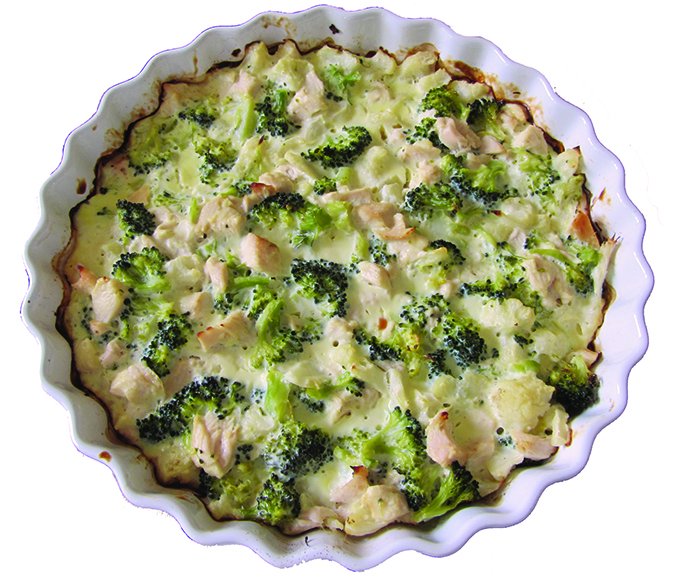
Ingredients:
2 cups (10 oz.) cooked turkey meat (light or dark, no skin), cut into pieces
1 cup (5 oz.) steamed broccoli
1 cup (5 oz.) steamed cauliflower
4 eggs
1/4 cup plain, lowfat yogurt
Preparation:
Steam broccoli and cauliflower for 8 minutes or until tender, and cut into bite-sized pieces (other vegetables may be substituted; see suggestions below). Beat eggs and yogurt together. Mix turkey and vegetables together in a quiche or glass pie pan (spray first with vegetable or olive oil cooking spray to prevent sticking). Pour egg mixture on top and stir, making sure the meat and vegetables are coated with egg. Bake at 350 degrees Fahrenheit for 30 minutes (can also be cooked at 375 degrees on top shelf if preparing at the same time as the rice dish). Dish is ready when a fork inserted comes out clean. Makes 8 servings (3.5 oz. each).
Nutritional Analysis per Serving
100 calories, 15g protein, 3g fat, 3g carbohydrates.
Substitutions
Zucchini, spinach, asparagus, bell pepper, green beans, or sweet potato. Chicken instead of turkey.
Quick & Easy Version
Mix leftover turkey with egg, plain yogurt, vegetables, mashed potatoes, mashed sweet potatoes or canned pumpkin.
Rice, Apple & Giblet Stuffing
Broth from giblets gives brown rice an intoxicating flavor for dogs, and the addition of the giblets as well makes this dish suitable for a meal. This recipe can be made with a smaller amount of giblets (such as from a chicken) or a larger amount of rice when combined with other high-protein foods.
Ingredients:
Giblets from one turkey (liver, heart and gizzard, about 6.5 oz.)
1 cup brown rice (dry)
2 small apples, diced or cubed
2.5 cups of water
Preparation:
Combine water and giblets and bring to a boil, then reduce heat and simmer for 20 to 30 minutes. Remove the giblets and let the water cool a bit. Spray a 2-quart baking dish with olive or vegetable oil cooking spray. Add brown rice and cooled water from the giblets and mix together well. Cover and bake at 375 degrees fahrenheit for 45 minutes. Remove from oven; rice should be almost fully cooked with most of the water absorbed. Add chopped giblets and apples. Return to oven and bake for another 15 minutes uncovered. Makes 12 servings (1/2 cup each).
Nutritional Analysis per Serving
100 calories, 4.5g protein, 2.3g fat, 15.6g carbohydrates.
Optional extras if you want to share with your dog:
Dried cranberries, celery, parsley, thyme, poultry seasoning.
Quick & Easy Version
Mix giblets with cooked rice and/or vegetables.
Mini Pumpkin Pies
Pumpkin is good for dogs, but they don’t need the extra sugar and spices found in pumpkin pie mix. This recipe uses a low-fat, low-calorie crust suitable for dogs.
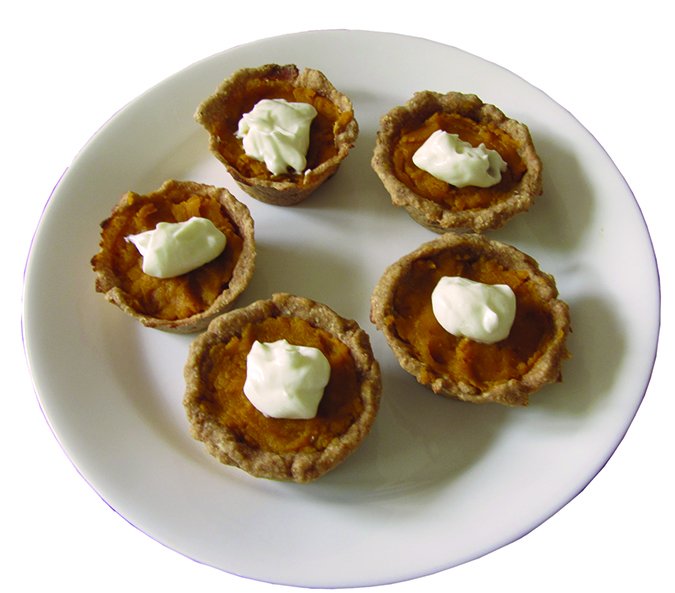
Ingredients:
16 oz. canned pumpkin (plain)
8 oz. plain, low-fat yogurt
3/4 cup wheat flour, or a mixture of all purpose and whole wheat flour
1/2 cup oatmeal
1/4 cup applesauce, unsweetened
3-4 tbsp. water
Preparation:
Mix oatmeal and flour together in a food processor. Add applesauce slowly, continuing to run processor. Add water slowly, using only enough to make a ball form (too much water will make the dough sticky). Spray wax paper and muffin tin with olive or vegetable oil cooking spray. Roll out dough onto wax paper and cut out 8 circles, about 4″ across (alternatively divide dough into eight small balls before rolling). Press individual dough circles into bottom and sides of muffin tin. Bake at 375 degrees Fahrenheit for 8 minutes. Let crusts cool, then remove from the muffin tin. Fill each crust with about 1/4 cup (2 oz.) of canned pumpkin. Top with a dollop of yogurt. Makes 8 mini pumpkin pies.
Nutritional Analysis per Pie
100 calories, 4g protein, 1g fat, 20g carbohydrates.
Optional Extras:
Cinnamon, ginger and honey can be mixed in or added on top if desired.
Quick & Easy Version:
Give a scoop of canned pumpkin with a spoonful of plain yogurt on top (crustless version is much lower in calories).
Healthy Substitutions for Dogs
| INSTEAD OF THIS: | FEED THIS: |
| Turkey skin or drippings | Turkey meat (skinless) |
| Fatty ham scraps | Lean ham meat |
| Cooked bones | Giblets (not too much at one time) |
| Gravy made from drippings | Low-fat gravy |
| Stuffing with onions | Stuffing without onions |
| Candied yams and marshmallows | Sweet potato or yams |
| Potatoes with butter and/or sour cream | Plain mashed potatoes |
| Cheese and sausage | Celery or carrot sticks |
| Green bean casserole with onions | Green beans |
| Broccoli casserole with cheese | Broccoli |
| Brussels sprouts with bacon | Brussels sprouts with a few bacon bits |
| Pearl onions | Creamed corn |
| Applesauce with added sugar | Unsweetened applesauce |
| Grapes or raisins | Blueberries and dried cranberries |
| Apple pie | Apple slices |
| Berry pie | Berries |
| Pumpkin pie | Canned pumpkin |
| Nutmeg | Cinnamon |
| Whipped cream | Yogurt (plain) |
| Alcohol | Water flavored with low-fat gravy |
Author Mary Straus would like to extend special thanks to Jill and her taste testers: Etta, Raisin’ (a 15-year-old Cairn Terrier), and Chip, a 12-year-old Norwich Terrier).


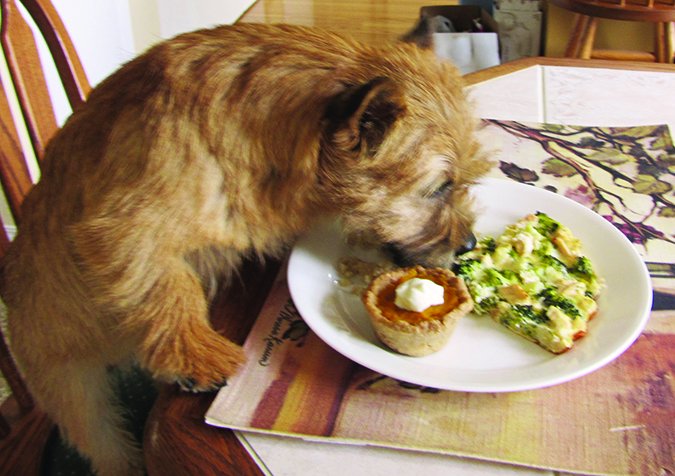

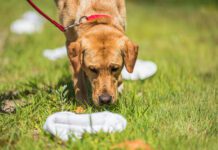

Sadly, most dog lovers are NOT animal lovers, and are speciesists, not caring about the animals they and their dogs eat. How hypocritical!
I and my dog are thriving on a vegan diet.
Good on you being vegan is great if it’s your choice. Your dog how ever has no choice But if feeding raw meat repulses you kibble is pretty much the same as vegan as many kibble products have byproducts ie feathers not infact meat
Wow thats pretty harsh don’t you think? Just because its your choice doesn’t mean its good for everyone…
OMG, you pompous ass. Just for your information, you pompous ASS, dogs and cats DO NOT THRIVE on vegetarian diets. Do a little research before you spew your totally WRONG information.
That’s pretty arrogant, but most vegans are. No, your dog is not thriving, and neither are you. Carnivores and omnivores need protein derived from animal sources. You cannot continue to function properly supplementing yourself using peas and other legumes as protein. In the long term, your brain will simply stop functioning because your body cannot process B vitamins without animal proteins. You will begin to exhibit symptoms similar to senile dementia, or an Alzheimer’s patient. Hopefully your physician will be familiar enough with your lifestyle to recognize what is wrong, and will catch it in time to reverse the damage before it become permanent.
You mistake people with common sense with “speciesists”, whatever the heck that is. Take a good look at your dog. His eyes are in front of his head. That’s because he is a predator. He hunts for his food. Now, where are your eyes? The same place. You are also a hunter, predator. You are also meant to hunt for your food. You are designed by your Creator to eat meat, and to hunt for your food. Not my opinion, it is just science. Now, please stop using your pompous, ” I am morally superior to you” attitude to abuse your dog, and feed him the way he is supposed to be fed. I couldn’t care less how you choose to abuse your own body, but abusing your dog, that’s another story.
I am a vegan and so are my two Scotties. The Scots like the dry kibble called V Dog and I cook their wet food using fresh plant proteins and various legumes and rice. We are all well and healthy. Good idea to educate yourself with vegan diets before starting. On this day of Thanksgiving I am grateful to be able to enjoy a meal that does not result in the demise of some other creature. 🐾❤️
No Charlotte, neither dogs, cats, nor humans are meant to live without protein derived from animal sources. If you insist on depriving your animals, who are natural predators, of meat, at least give them protein from dairy sources, and/or eggs. If you don’t mind the gradual decline of your own brain and other functions because your body cannot properly process B vitamins, that’s your choice. But it is outright cruelty to animals to deprive your animals of what they naturally require.
Thanks for these yummy recipes. 🙂